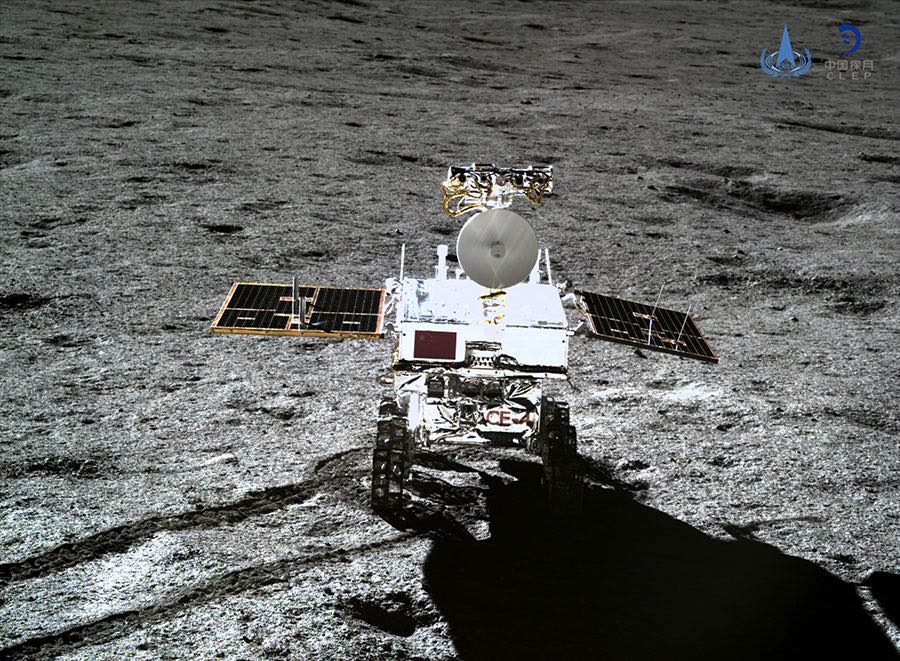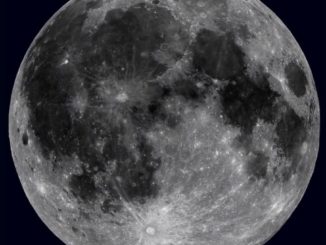
Chinese officials on Friday released more imagery from the Chang’e 4 mission, a robotic lander and rover exploring the far side of the moon after a successful landing Jan. 3.
The imagery released Friday included a new view of China’s Yutu 2 rover captured by a camera aboard the Chang’e 4 lander, a panoramic vista of the austere lunar landscape, and a sped-up video showing the spacecraft’s final descent to the moon from the view of the probe’s descent camera.
Chang’e 4 was set to enter a low-power sleep mode Sunday as the sun set on the landing site in Von Kármán crater, a bowl-shaped depression measuring around 110 miles (180 kilometers) in diameter located in the southern hemisphere of the far side of the moon.
Nighttime lasts 14 days on the lunar surface as the moon orbits the Earth once every 28 days, and temperatures are predicted to dip to minus 297 degrees Fahrenheit (minus 183 degrees Celsius) as the sun disappears below the horizon at Von Kármán crater.
Chang’e 4 will switch to a “sleep mode” as night falls as solar energy will no longer be available to power the probe. The spacecraft carries a radioisotope heat source and power generator to keep warm and generate electricity when the sun is below the horizon. The device was developed in collaboration between Russian and Chinese experts, according to China’s state-run Xinhua news agency.
The small electricity generator is not big enough to power the entire lander, but it will allow sensors to gather temperature data on the lunar surface throughout the night, Xinhua reported, a capability not carried on Chang’e 3, China’s previous lunar lander which touched down on the near side of the moon in 2013.
The descent camera video shows the Chang’e 4 spacecraft approaching the lunar surface, first flying on a horizontal trajectory, then transitioning to a vertical descent phase.
Chang’e 4’s landing sequence lasted around 12 minutes, beginning with ignition of the probe’s variable-thrust descent engine to slow the craft’s horizontal velocity from 3,800 mph (1.7 kilometers) per second to nearly zero. Then the spacecraft pitched over, a maneuver visible in the video released by the China National Space Administration on Friday, at an altitude of around 20,000 feet (6 kilometers) above the moon.
The video released by the Chinese space agency is sped up about two-and-a-half times normal speed, and it illustrates the difficulty of navigating across the airless lunar landscape. It’s challenging to visually ascertain the lander’s altitude, or gauge the relative size of the numerous craters visible in the video, but Chang’e 4 carried a laser ranging instrument to measure the spacecraft’s altitude and descent rate, feeding data to the probe’s guidance computer throughout the landing sequence.
The Chang’e 4 spacecraft paused its descent around 330 feet (100 meters) above the surface to search for safest place to touch down, using hazard avoidance algorithms to steer clear of craters and boulders. In the final seconds of the landing, Chang’e 4’s engine can be seen kicking up first before plopping down on four legs, achieving the first-ever soft landing on the far side of the moon at 0226 GMT on Jan. 3 (9:26 p.m. EST on Jan. 2).
Early results from the Chang’e 4 mission suggest the landing site in Von Kármán crater has fewer rocks strewn on its surface than Chang’e 3’s landing site on the near side of the moon. The surface at Von Kármán crater also appears to be covered in a thicker layer of fine dust.

The far side of the moon is more rugged than the near side, so Chinese officials adjusted the descent trajectory for the Chang’e 4 mission to a more vertical profile from the curved profile used on Chang’e 3, China’s previous lunar lander which touched down on the near side in 2013.
“We chose a vertical descent strategy to avoid the influence of the mountains on the flight track,” said Zhang He, executive director of the Chang’e 4 probe project from the China Academy of Space Technology, said in a report published by the Xinhua news agency.
On Earth, the landing craft weighs around 2,600 pounds (1,200 kilograms) without its propellant, and is about the size of a car. A few hours after landing, China’s 297-pound (135-kilogram) Yutu 2 rover rolled off the Chang’e 4 stationary landing platform to begin exploring.
The Yutu 2 rover was named after the mobile robot named Yutu that flew on the Chang’e 3 mission to the moon in 2013. Yutu means “jade rabbit” in Chinese, and is the name of the pet rabbit of the moon goddess Chang’e in Chinese folklore, the namesake of China’s lunar missions.
Chang’e 4’s lander and rover were originally built as spares for Chang’e 3, then modified for a new mission on the back side of the moon after Chang’e 3’s successful landing.
A video released by Chinese space officials are posted on YouTube by the Planetary Society shows the Yutu 2 rover driving on the moon, then using its wheels to turn in place.
Chang’e 4 carries a low frequency radio spectrometer developed by Chinese scientists for astrophysics research. A German-developed neutron and dosimetry instrument on the stationary lander will measure radiation levels at the Chang’e 4 landing site, collecting data that could be useful in planning human exploration of the lunar far side, studying solar activity, and gauging the underground water content in Von Kármán crater.
Yutu 2 hosts a ground-penetrating radar to study geologic layers buried under the landing site, and a visible and near-infrared spectrometer to gather data on soil composition. Chinese officials approved the addition of a Swedish instrument on the rover to study the interaction between the solar wind and the lunar surface, which is not shielded by an atmosphere from the bombardment of charged particles originating at the sun.
Chang’e 4 also delivered to the moon a student-designed carrier containing potato seeds and silkworm eggs. University students and scientists will monitor the growth of the organisms, which are housed inside a chamber and fed natural light and nutrients once on the lunar surface.
Chinese officials said Chang’e 4’s landing site is located at 177.6 degrees east longitude and 45.5 degrees south latitude on the moon, in a region known as South Pole-Aitken basin. The basin covers a large swath of the lunar far side’s southern hemisphere, and is believed by scientists to be one of the most ancient impact sites in the solar system, created when a large asteroid or comet struck the moon.

Scientific data and images from Chang’e 4 are relayed back to Earth through a dedicated communications satellite China launched last year. The Queqiao, or “magpie bridge,” spacecraft is positioned beyond the moon, with an antenna in view of both Chang’e 4 and Earth, allowing it to relay commands and signals between ground controllers and the lander.
Chang’e 4 was the 20th spacecraft in history to safely land on the moon, and China’s second lunar lander. China’s next lunar mission, Chang’e 5, could launch by the end of 2019 to land on the moon, scoop up samples and return the specimens to scientists on Earth for analysis in ground-based labs.
Email the author.
Follow Stephen Clark on Twitter: @StephenClark1.



